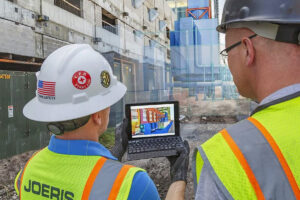
Augmented Reality Is The New Reality In Construction
Augmented reality promises to be the next big trend in the construction field. It is currently used primarily in video games and is often confused with virtual reality, but the two have different applications
Virtual reality replaces the real world with a simulated version. Augmented reality, on the other hand, takes a real-world view and overlays it with a 3D design. It does this by using GPS and advanced camera and sensor technology that combine physical surroundings with computer generated information, presenting the end result in real time. This allows builders to show clients proposed designs on iPads and other mobile devices, without ever having to leave the construction site.
presenting the end result in real time. This allows builders to show clients proposed designs on iPads and other mobile devices, without ever having to leave the construction site.
Affordability
Until recently, augmented reality was only practical for larger architecture, engineering and construction firms that could afford the necessary technology teams needed to devote the hours required to tweak and fit a platform that was workable. But that accessibility is changing for smaller firms, thanks to more advanced technology and lower costs based on a per-project basis rather than previous large up-front fees.
In building, this means that construction managers can use the software to create designs for buildings instantly on site or at the table in a conference room with clients, boosting a construction firm’s credibility.
Safety
Another potential benefit for augmented reality is its ability to create products that can keep construction workers safe, such as helmets that can monitor employees’ vital signs such as heart rate, skin temperature, stress level, attention and fatigue. This will allow construction managers to spot problems and safety risks before they happen, protecting workers, and budgetary and scheduling concerns.
Benefits of Augmented Reality in Construction
Augmented reality can also allow the architect and the contractor to collaborate on design changes post-approval but pre-construction. This can help to address any clashes or issues that might arise during or after construction.
In addition, augmented reality can be a reference tool during construction investigations. For example, in 2011, after an earthquake in Christchurch, New Zealand destroyed parts of the city, augmented reality technology gave city planners and engineers the ability to visualize the buildings that were destroyed. Today, New Zealand uses augmented reality in many of its disaster investigations.
Other Benefits of Augmented Reality in the Field
Project Planning
Augmented reality makes it possible to generate 3D models on 2D plans, producing detailed, interactive models prior to actual construction. This is a financial benefit because it allows for changes to be made before building begins. It also keeps the client engaged in the process, and can prevent schedule delays, reduce costs overruns, and identify mistakes before they happen.
Automated Measurements
Because augmented reality technology can measure a space’s physical properties such as height, width and depth, it provides a more comprehensive view of what a project will look like and what labor and materials are needed. These measurements can also be done on-site, allowing workers to locate any potential inconsistencies in the structures and adjust them, preventing higher costs and delays in the process.
Modifications
Augmented reality enables employees to make changes at the job site, such as virtually removing and relocating walls or modifying layouts or troubleshooting any errors prior to construction. This can improve workflow and prevent wasted materials.
Onsite Information
Augmented reality permits workers to access the locations of pipes, walls, outlets, switches and ventilation, preventing second guessing. It also provides an effective means to monitor a project against the building plan and incorporate any additions correctly.
Teamwork
Because construction projects require collaboration between carpenters, electricians, plumbers, welders, designers, construction workers and managers, augmented reality allows for consultations to take place both on site and remotely between all parties involved. This can greatly lower the time and costs accrued during decision making and the headaches involved in trying to get the whole team together at the job site.
Overcoming Resistance in the Workplace
Despite the many benefits and uses of augmented reality programs, it has met with some resistance in the construction field. Part of that stems from costs. While augmented reality is becoming more affordable to implement, many augmented reality firms still charge large up-front fees unattainable for smaller construction firms. However, this pricey glitch is expected to continue to diminish, as the technology improves and more competitors enter the market.
Another area that is holding augmented reality usage back is its potential to provide inaccurate information. While the technology allows construction firms to see parts of a project, this view is sometimes inaccurate or unreliable. This stems from the differences in real life construction zones and that seen on a computer. For example, a construction zone has constant movement that includes building structures, moving heavy objects, and plans changing spontaneously. Augmented reality, on the other hand, is conducted in a static environment that doesn’t factor in any changes. This unreliability has resulted in a negative reaction in a field that is dependent on being able to rely on the software and hardware tools it uses. It is predicted, however, that these challenges will be overcome in the future as the technology improves over time.
From Novelty to Commonplace
As augmented reality technology continues to advance and improve, it will aid construction teams in creating more efficient and accurate projects. This makes it an invaluable tool that will play a huge role in changing the face and future of building construction.
